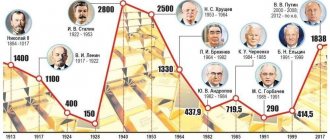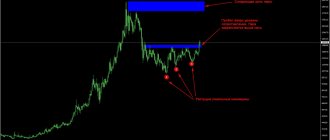Greetings! The instability of the global economy, embargoes, trade wars and local conflicts make bankers and ordinary people nervous. Added to these events are rumors about the imminent awakening of the Yellowstone supervolcano, the US going under water, the refusal of many countries to use the dollar, and even a world war. And there is nothing funny about it. Everything that seemed like vain fears yesterday can become a reality tomorrow.
I suggest you think about what will happen to gold if the dollar collapses? After all, metal and paper money have lost value many times. How will the price of the precious metal behave in this case? I won’t guess or predict, but will simply talk about what affects its value and what the prospects are.
What affects the price of gold
Since the beginning of exchange trading in the metal in 1792, its price has fluctuated from $19 to $30 per troy ounce. Some stability came with the adoption of the Bretton Woods system in 1944, when $35 was equal to one ounce. For a couple of decades, gold was pegged to the dollar. But the depletion of US reserves by the 1970s forced Nixon to end the dollar's equivalence to gold. Since then, the value has increased significantly, and the precious metal itself has become an example of a reliable reserve. But even for this reserve the price fluctuates for many reasons.
The metal constantly becomes more expensive and becomes cheaper for a short time. The cost depends on many factors, because this is not an ordinary commodity like steel or grain. In addition to market relations, the quote is also influenced by political events and investment attractiveness. Influencing factors can be divided into two groups.
The first is commodity relations:
- Demand in the jewelry market.
- Level of consumption by industrial enterprises.
- Depletion of developed deposits, increased cost of production and exploration of new ones.
- The inability or unwillingness of mining companies to fully meet demand.
Second - others:
- Political crises and natural disasters in leading exporting countries.
- Global economic situation and crises in the development of the world economy.
- Buying or selling by central banks of large states.
- Speculation in commodity, currency and stock markets.
- Dollar exchange rate on the world foreign exchange market.
If the first can be attributed to objective factors, then with the second group, on the one hand, it is more difficult, and on the other, simpler. It’s more difficult because all the factors are subjective. It’s simpler because in the end it all comes down to the inextricable gold-dollar pair.
Gold in a rising dollar atmosphere - World Gold Council
Market analysts seem to agree on two things: first, that a strong dollar is bad for gold, and second, that the dollar is likely to continue to rise in value. We can agree that a strong dollar can put pressure on gold, but analysts at the World Gold Council (hereinafter - WGC) believe that the dollar/gold relationship is asymmetric: the price of gold rises more in a weak dollar than it falls in price in a strong dollar . Additionally, history shows that the benefits of owning gold for investment portfolios outweigh the challenges created by a strong dollar. Gold is stable, given good supply and demand indicators, increased geopolitical risk and decreasing returns on risky assets. In addition, pressure on the dollar will also increase as we move towards a multi-currency world.
The US dollar is an important - but not the only - factor influencing gold
It is always easy to analyze any phenomenon in terms of “good and bad”. The saying “what's good for the dollar is bad for gold” is no exception. However, the actual situation on the gold market has many more nuances and sides. We can agree that as long as the dollar continues to rise, the gold rate will be constrained. However, the relationship between the dollar and gold is more complex today than in the past. The current situation is different from what it was during the 1970s-1990s. and will likely continue to change. The current macroeconomic environment is characterized by unprecedented monetary policy, low rates, high equity prices and the prospect of deflation in many parts of the developed world. In addition, the influence of emerging markets has increased and we are slowly but surely moving towards a multi-currency financial system. While the dollar remains an important factor for gold, its influence is likely to diminish. The World Gold Council analyzed the dollar/gold ratio to better understand what to expect in the short term. We present the conclusions of this analysis:
— The dollar may rise in the short term, but growth will soon slow down. It is known that the dollar has reached multi-year highs over the past 12 months. This is partly due to US economic growth and differences between US monetary policy and other parts of the world. However, the pace of dollar appreciation will be constrained by the low growth potential of the US economy and the consequences of a prolonged period of low real interest rates;
— Despite the strengthening of the dollar, prospects for gold remain stable. According to the VZS, gold production will remain limited, which will put less pressure on demand and support the rate. Moreover, the benefits of lower oil prices for consumers may be outweighed by geopolitical instability and credit risk - an atmosphere in which gold takes to the waters. Moreover, stock and bond prices continue to show an imbalance between risk and return, prompting investors to seek alternative assets;
— owning gold has great benefits, even despite the consequences of a stronger dollar. VZS research shows that investors still prefer to make strategic holdings of gold, even with the most modest forecasts for its growth, even when the dollar is rising and US stocks and bonds are predicted to surge in prices;
— the dollar/gold ratio continues to develop. Changes in global markets and gold market structure should reduce the dollar's influence on gold in the long term. And while the fact that gold is denominated in US dollars attracts a lot of attention, the significance of this fact is exaggerated.
The dollar may increase in value, but this trend will not last forever
The general consensus is that the dollar will continue to rise in the near future based on the following factors: the expansion of the US economy, the prospect of tightening US monetary policy, weakening economic conditions in Europe and China and some countries dependent on the export of raw materials, loose monetary policy in Japan, Europe and other countries. At the same time, the rise in the dollar will not lead to a serious collapse in the gold rate. And that's why:
— as you know, the dollar reached a 12-year high this year. However, historically, the correlation between the dollar's growth over 12 months and the next year is such that the dollar tends to lose ground. Only in the early 1980s. The dollar increased in value over a long period of time. But this was a period in history with dynamics that are very different from modern ones;
- A flat yield curve suggests that the rate of economic growth is unsustainable. US short-term rates are moving higher, while the long end of the curve is steadily declining. The current yield curve is even lower compared to previous dollar rally years. The data reflects widespread uncertainty in the market about long-term growth and the prospect of high inflation in the future - ideal conditions for raising rates and holding down the currency - as both authorities and market analysts say. Weak growth in Europe and China, among other regions, is partly to blame for the dollar's strength and will likely weigh on U.S. economic growth.
— The Fed will move cautiously, while increasing debt will remain an acute problem. The Fed has made it clear that its policy depends on economic data. Such a policy, by definition, involves a time lag. In this case, real rates will remain low - which, in turn, should stop the dollar from rising. In addition, Fed officials expressed concern that weak growth in other key countries and a stronger dollar could slow the US economy. In addition, and not just in the US, high levels of government debt keep interest rates from rising, preventing borrowers from being able to repay their debts. Containing interest rates should also slow the dollar's appreciation.
Further increases in dollar strength could lead to corrections, but not shocks
Steady dollar growth will not necessarily lead to further weakening of gold. There are other factors that support gold even with a strong dollar. GZS research shows that, as is often the case with gold, the factors are complex and it is easy to fall prey to misconceptions. While a strong US dollar may continue to weigh on gold, there are many factors limiting its impact. But first, let's talk about the myths associated with the dollar/gold ratio.
Myths and misconceptions regarding the dollar/gold ratio
You can often hear from market participants that the basis for the dollar/gold ratio is that the gold rate is expressed in dollars. There are two main problems with this statement. While it is true that the gold rate is often “expressed” in dollars, the rate is not dictated by the dollar. The dollar/gold ratio corresponds to the dollar's position as - as some say - a reserve currency. Additionally, it is necessary to consider the supply and demand implications of gold, which are expressed in dollar terms. From a demand perspective, the exchange price of any homogeneous commodity (gold, oil, etc.) is less important to investors and consumers than the price paid for it in local currency. On the supply side, the relative strength of the local currency can have an impact on production. Professor Martin Feldstein from Harvard University showed how this works using oil as an example. In his opinion, the local oil price moves against the dollar, which reflects its movement against the local currency. Thus, a decrease in the dollar price of gold (for example) only affects the change in the exchange rate of the dollar relative to the price of the local currency.
A strong dollar is a relative term, especially when it comes to gold
It is common to talk about the appreciation or depreciation of a currency in such a way as to give the impression that the exchange rate is almost a completely independent variable. In fact, currencies can strengthen against some currencies and move in the opposite direction against others. In order to properly measure the strength of a particular currency, investors rely on indices, which record the relative strength of a given currency relative to various other currencies at the same time. In the case of the dollar, a popular benchmark is the trade-weighted dollar index created by the Fed. However, the index's performance is heavily weighted by the dollar versus the euro or Canadian dollar (large trading partners) but has little regard for the Indian rupee or Turkish lira (smaller trading partners). But to truly understand the relationship between the dollar and gold, it is more relevant to measure the strength (or weakness) of the dollar relative to the currencies of countries with higher levels of gold demand. For example, measuring the value of the dollar against the Indian rupee will be more appropriate than measuring the value of the US dollar against the Canadian currency.
The market always predicts a strong dollar
In our opinion, the current gold price reflects market expectations for a stronger dollar, but the dollar's upside potential may be limited. Most analysts do not expect the euro to fall below parity against the dollar. However, certain events may occur that could cause the dollar to spike, such as the breakup of the eurozone or the default of dollar-denominated loans. However, these types of events usually increase the demand for gold, since it is a store of value. There are also other currencies that are important to the gold market, such as the Indian rupee, which has the potential to appreciate, or the Chinese yuan, which is increasingly moving away from the dollar.
Gold production has decreased now compared to periods of strong dollar
In the early 1980s. and the mid-1990s, when there was also a large rise in the dollar, the gold rate declined. But in those years, strong production growth became an additional factor of pressure on its rate. Production grew at an annual rate of 8.3% during this period, compared with a rate of 0.9% in other years. At the same time, net sales of gold by central banks increased by 16.3%, while in other years the same figure fell to 1.3%. Currently, while the dollar is strengthening, gold production is unlikely to rise to 1980s levels. In recent years, total gold production (including refining) has decreased. In this case, the gold market receives support:
— the supply of processed gold is constantly decreasing. In 2009-2014 it fell to a seven-year low, falling by more than 600 tons;
- gold production may level off next year as supply increases from gold mining companies that have developed during a period of higher gold prices;
- While gold exchange-traded funds can serve as a source of gold supply, it is unlikely that there will be a large-scale outflow of shares from them in the near future. Most tactical and speculative investors have exited the market, leaving only strategic investors in gold ETFs.
Gold's Position in a Rising Dollar
Historical Perspective on Gold's Conditions During Various Dollar Regimes
The US dollar is by no means the only factor influencing gold, but in the absence of major changes among other factors, investors are focusing their attention on the dollar/gold ratio. It is interesting to look at periods in which a similar situation was observed to analyze the movement of the gold rate in relation to how quickly the dollar rose or fell. Let's take a 40-year period for analysis (from January 1973 to December 2014; see table) and divide the dollar movement based on the following three categories:
— fall: the dollar depreciates by more than 2% over a 12-month period;
- slight dynamics: the dollar moves up or down by 2% over a 12-month period;
- growth: the dollar rises by more than 2% over a 12-month period.
Based on the results of the analysis, we can say that gold shows the best dynamics (+14.9%) during the fall of the dollar. Gold also shows growth, although to a lesser extent, when the dollar has little momentum. On the other hand, the gold rate falls (-6.5%) during periods when the dollar rises. Gold typically rises more than twice as much when the dollar falls than when the yellow metal falls when the dollar rises. Additionally, gold's correlation to equity markets and commodities tends to be below average during periods of rising dollar. This becomes important in the context of a balanced portfolio because the dollar is not as significant from a diversification perspective.
Table 1: The dollar/gold relationship is not symmetrical: exchange rate
gold doubles during dollar weakening
Average annual gold performance statistics from January 1973 to December 2014
| Conditional Analysis | ||||
| All period | Falling dollar | Nebol. dynam. | Dollar growth | |
| Profitability (annual) | 6.2% | 14.9% | 7.8% | -6.5% |
| Volatility (annual) | 19.5% | 18.4% | 20.2% | 19.7% |
| Correlation with fund. markets | -0.06 | 0.07 | -0.16 | -0.11 |
| Correlation with commodities | 0.15 | 0.16 | 0.14 | 0.07 |
Source: Bloomberg, World Gold Council
Gold improves the health of an investment portfolio even in a rising dollar
Should investors hold gold in a rising dollar? In our opinion, they certainly should. In the long term, the optimal investment in gold in a balanced portfolio should be from 2 to 10% (depending on risk tolerance).
Moving towards a multi-currency world
In the long term, there is one important development related to the dollar that needs to be considered along with near-term events. This is a downward trend in its rate. Instead of the “collapse” of the dollar that was wrongly predicted many years ago, there are signs of a future transition to a balanced multi-currency system.
Tests for the dollar
In 1971, the US authorities announced that the dollar would no longer be convertible into gold. This marked the end of the Bretton Woods system. Since then, the dollar has floated freely compared to other currencies. In general, the trend is that the dollar is falling in value due to macroeconomic factors - such as falling interest rates, the rise of the euro and emerging market currencies. Despite strengthening over recent years, the long-term downtrend, or at least pressure relative to the uptrend, will gain momentum. Let's look at the factors that put pressure on the dollar:
- appreciation of the yuan. China is now the world's second-largest economy, and its currency is likely to dominate international reserves in the future. As you know, China has entered into swap agreements with 23 central banks. China's importance on the world stage has not yet been fully reflected in its currency. It is quite possible that we will see an increase in the role of the yuan;
— a decrease in the share of the dollar in world reserves. The dollar's share of world reserves has fallen slowly but steadily - from 61% in 2000 to 55% in 2014 - while the euro's share has risen from 15% to 22%. The share of other currencies is also growing, in particular the Canadian and Australian dollars. However, while these currencies are gaining a larger share of global reserves, their effectiveness in diversifying foreign exchange reserves may decline if their central banks' monetary policy actions become more synchronized. Consequently, gold will become a more valuable tool for central banks to diversify foreign exchange reserves.
Once again about the dollar/gold ratio
VZS analysts believe that there are signs of a change in the dollar/gold ratio:
- Demand for gold, not denominated in dollars, is not overly sensitive to dollar movements. Demand for gold outside the United States is not clearly tied to the dynamics of the dollar. China and India account for 50% of total gold demand, with Southeast Asia accounting for another 9%. Demand from China is likely to increase even if the dollar rises or falls in value. Demand from India is more dependent on the volatility of the local currency and cultural factors than on the dynamics of foreign currencies and the global financial situation. The growing influence of East Asia not only in the gold markets, but also in the capital markets as a whole, of course, is unlikely to break, but it will certainly weaken gold's dependence on the dollar;
— Asia is becoming the center of gold trading. The trend of large trade in the yellow metal moving to the East is becoming evident as the global gold market is rapidly developing in Asian countries such as China, Hong Kong and Singapore. Examples of this trend are the creation of the international council of the Shanghai Gold Exchange, the emergence of gold kilobar contracts on the Singapore Gold Exchange, new kilogram gold bar futures in Hong Kong, etc. All of this is likely to lead to more gold trading in other currencies as the gold market becomes less centralized (previously centered on London) and more regional, networked.
The Dollar Matters, But It Doesn't Determine Gold's Value to Investors
While dollar strength may put additional pressure on gold in the short term, as long as the strength is not too great, the benefits of owning gold in an investment portfolio will remain significant. Over the medium term, demand from the East and limited production will provide support for the gold market. And finally, in the long term, VZS analysts believe that the dollar’s influence on the gold rate will decrease as other currencies begin to challenge the dollar’s leading position as the world’s only reserve currency.
How does the dollar exchange rate affect gold?
It does influence, but not directly. Why is that? Because the price depends on multidirectional factors. They are mixed with seasonal demand, local wars, mine accidents, the desire of investors to take risks and much more. Therefore, fluctuations in the dollar exchange rate are not reflected in the quotes of the precious metal. However, the mutual influence is very noticeable. After all, payments for the purchase of gold on the world market are carried out in American dollars.
The dependence is especially noticeable in times of crisis. Uncertainty forces investors to transfer assets into “safe haven” currencies – the yen and the Swiss franc, and buy gold. The same thing happens when negative news appears about the state of the US economy. Any concerns about the stability of the dollar lead to an increase in the price of the precious metal. The collapse of the dollar means an increase in the price of gold. And vice versa.
What should you pay attention to when buying and selling gold?
Since precious metals have always attracted and continue to attract the attention of scammers, it is worth following several rules when buying and selling them. So, for example, you should not agree to the first price named by the buyer, but you should definitely study the market and consult with at least two jewelers. In addition, be sure to ask the buyer for documents confirming the value of gold today and allowing him to conduct activities to purchase precious metals from the population. At the same time, you should also not follow the lead of a person who does not want to take into account the hallmark of your gold product when determining the price.
It would be best to contact official pawn shops, but in the same case, when you want to buy or sell investment gold, you will need to go to any bank. Remember that the sale of gold in Russia by private individuals is prohibited, and serious criminal liability has been established for this.
As for working on the Forex exchange, there are no obstacles here, since in this case trading does not take place in real gold, but only dollar-gold pairs are bought and sold. Moreover, all trading takes place through specialized brokerage agencies or brokers.
0
What will happen to gold if the dollar collapses?
Expert opinion
Vladimir Silchenko
Private investor, entrepreneur and blog author
Ask a Question
It's OK! It does not rot, does not rust and does not burn. Can only melt in fire. Then it cools down and still remains yellow metal. Therefore, in a physical sense, even because of a fatal catastrophe - the collapse of the dollar - nothing will happen to gold. Ingots or products will receive value in other currencies.
Of course, a falling dollar always leads to uncertainty in the global market. The emerging turbulence forces people to look for safe havens for investments. And gold is a quiet backwater and the world’s main reserve currency. Therefore, from the financial side, nothing bad is expected from the dollar collapsing. An absolute collapse of the dollar or a severe depreciation will not reduce the value of gold in other currencies.
Question - what will the cost be? At a minimum, the equivalent of goods that can be bought for a troy ounce will remain. At the most, it will change for the better. The stability of gold has been proven over thousands of years.
The epidemic almost killed the market
The coronavirus epidemic and related restrictions last year led to an almost complete stop in the work of manufacturers. Due to mall closures, many jewelry chains were closed for an average of two to four months.
Of all the retail segments, the jewelry market suffered the most, notes General Director of Infoline-Analytics Mikhail Burmistrov. Retailers were forced to close retail facilities that, due to a decrease in traffic, turned out to be economically ineffective, he recalls.
Last summer, the jewelry chain “585 Gold” and Moscow Jewelry announced a reduction in the number of stores. “In general, the unstable economic situation, a sharp decline in purchasing power and a reorientation of demand for food and medicine have led to the fact that sales of jewelry have stalled, because this is not an essential item,” recalls Utkin.
Since the industry was not included in the list of those most affected, the Guild of Jewelers in April 2021 appealed to the Minister of Industry and Trade Denis Manturov. Without government support, the consequences for the industry will be catastrophic, the jewelers wrote. They asked to provide the industry with a tax holiday, restructure loans, transfer rent payments to a percentage of revenue, reduce insurance rates and increase unemployment benefits.
Advertising on Forbes
“Family companies sometimes make decisions that seem reckless”: the head of Tous in Russia - on how jewelry brands are surviving the pandemic
As a result, the jewelry trade was included in the list of victims (they were able to take advantage of government support measures: loans for wages, preferential rates for social insurance, etc. - Forbes ), but Russian manufacturers were left with nothing, Utkin complains. “There is some kind of disdainful attitude towards jewelers in Russia. Everyone thinks that they are already rich because they produce luxury goods, but no one digs up gold in their garden,” he says.
Almost all production in Russia is focused on producing products in the budget price segment, where the average bill is 8,000 rubles. These are mainly individual jewelry made of silver and lightweight gold items. 98% of enterprises in the industry belong to small and micro businesses, notes Utkin; in the regions of traditional jewelry production, the family format has been developed, says Maxim Guterman, commercial director of jewelry (Karatov brand).
Is gold rising or falling now?
There has been constant growth since 2000, when the asset price was only $300. In 2012, gold fell slightly and the price followed a corridor from $1100 to $1400. Starting from September 2018, there has been an increase in quotes with small pullbacks. Today the price is slightly adjusted, which serves as a buy signal for traders.
Online gold exchange rate chart
Now you can see the price of gold in US dollars online on the chart:
Gold, Silver and Platinum Quotes from TradingView
Current reserves and production of gold in the world
The noble metal has been mined for 6 thousand years, and, according to various estimates, above-ground reserves range from 150 thousand to 2.5 million tons. The big difference is due to the fact that the metal is used in technology, medicine and industry, and is stored in the reserves of central banks and private savings in the form of jewelry, coins and bullion. The WGC (World Gold Council) estimates reserves at 192 thousand tons.
Compared to reserves, production prospects are small. According to Metals Focus, at the end of 2021 there were only about 57.3 thousand tons remaining in underground storerooms. Now the annual production is about 3200 tons. Therefore, if new super deposits are not discovered, the reserves may be depleted by 2034.










